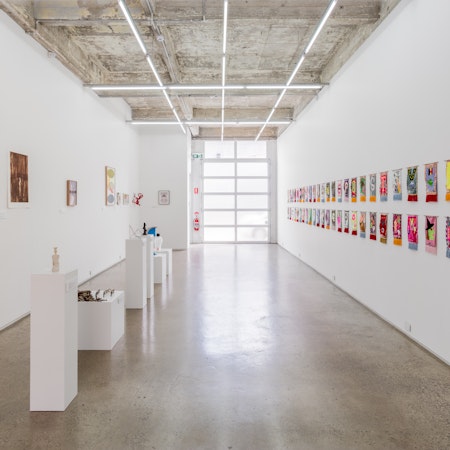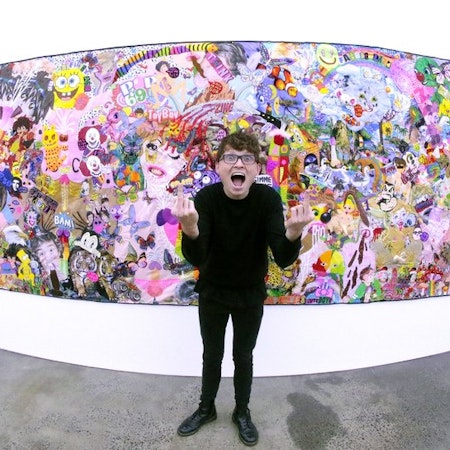Mark Feary: The concept of creating 52 unique works relating to fears, phobias and anxieties aligned to letters of the alphabet is intriguing. Could you discuss how you devised your project for this year’s Gertrude Edition?
Paul Yore: From the outset, I knew I was going to make each piece entirely from scratch, as I avoid using modes of mechanical reproduction in my work — I couldn't print or cast multiple copies of a single work. So I started thinking about how the Gertrude Edition generally contained about 50 or so individual pieces, and I wanted to allow this numerical value to frame the project conceptually. I came up with the idea of the series comprising 52 works — two works each to represent every letter of the alphabet, both in uppercase and lowercase forms. I have used alphabets in my previous works, which, taking the form of textiles, lend themselves easily to the vernacular of cheery nursery-room pedagogical charts (‘A’ is for apple, and so on). These devices, designed to stimulate the earliest stages of language acquisition, fascinate me. But I find something menacing about the rigid categorisation of the world that involves pinning something down with a name, and therefore ‘knowing’ it. The way we perceive reality is so heavily informed by these earliest childhood encounters. I decided to try and imbue my alphabet series with some dark Freudian notion of neurosis and perversities that have their root in the nascent years, and came up with an index of fears and aversions to correspond to each letter. So instead of ‘A’ is for apple, for example, I have ‘A’ is for ailurophobia (an extreme dislike of cats).
MF: Your practice spans across multiple mediums and often integrates found objects. How do you select these items for inclusion within the composition of your work?
PY: I have this idea about the arbitrariness of things that often underpins my work. I feel that even if a material was consciously chosen with some rigorously delineated conceptual reasoning, there would always be endless ‘unknowns’ involved in the decision. Everything that exists has some secret history that can never be entirely discovered, so I figure that to choose one thing over another thing is inherently absurd. I allow this absurdity to be the guiding principle in my decision making process, and I gravitate towards objects that resonate with whatever my intention is in that moment. I have always been attracted to things of pathos or humour, because I think art should elucidate the emotive world of lived experience — of confusion, desire or despair.
MF: Your sculptural works in particular feature these found objects, as evident inLove is Everything that was recently shown in your Neon Parc exhibition earlier this year. What is your approach to creating these incredibly detailed, dense and intricate installations? Are they processed-based work, constructed organically, or meticulously planned for a specific result?
PY: My sculptural installations are accumulative pieces spanning many years of collecting and constructing. Technically speaking, Love is Everything was the eighth incarnation of a singular, ongoing work that has expanded and changed dramatically since its beginnings in 2008. Each new context for the work informs its shape and content, and I use the piece as a vehicle for the disparate concerns I have in each particular setting. The pieces are built in a very haphazard way, but I always feel a piece must have an underlying order that gives shape to the chaos of the surface.
MF: Thinking back over the past three years, how has your experience at Gertrude Contemporary influenced your current practice and where you are today?
PY: My residency at Gertrude Contemporary was the perfect buffer between the sheltered working environment of art school and the cutthroat environment of the arts industry. Having the independence to work in solitude, being able to freely experiment, but also to have critical feedback and a support network is invaluable. Gertrude also opened my practice up to engagement with a broader arts audience, which is vital as a young artist when you are just trying to get your work seen.
MF: If you could give one piece of advice to an early practice artist about to commence their residency at Gertrude Contemporary, what would it be?
PY: My advice would be — don’t be too precious about your work… use the time to experiment widely and try new things. Engage with other artists, even if you are antisocial. It is really good to see other approaches to the studio up close. And one last thing: make the most of it because time flies by and you will miss it, particularly as a young artist, it is a real luxury to have access to your own large studio space 24/7. This might not always be the case.
MF: What exhibitions are you working toward at the moment?
PY: I am showing at the NADA Miami Beach art fair with Neon Parc in December, and working on a new series of textile works for a solo show at Hugo Michell Gallery in Adelaide in March 2017.
MF: What are you reading at the moment?
PY: On Ugliness by Umberto Eco.

